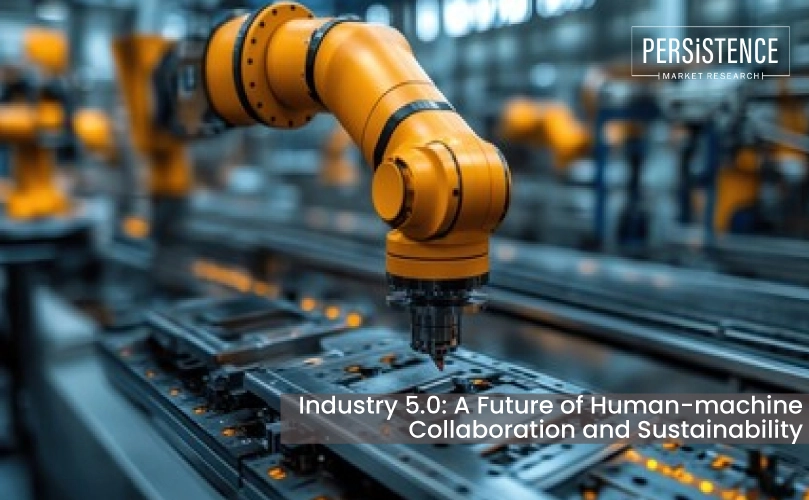- Blog
- Industry 5 0 A Future Of Human Machine Collaboration And Sustainability
Industry 5.0: A Future of Human-machine Collaboration and Sustainability
Published On : 4 Nov 2024
As industrial development advances, Industry 5.0 shifts its focus from fully automated production (Industry 4.0) to a more sustainable, human-centered, and collaborative approach. It combines cutting-edge technology with human creativity, developing a productive, adaptable, and environmentally friendly environment.

Key Differences between Industry 4.0 and Industry 5.0
- Human-centric Focus: Industry 4.0 focused on achieving maximum efficiency through automation, whereas Industry 5.0 emphasizes human-machine collaboration, empowering workers by placing them at the center of production.
- Sustainability: Unlike Industry 4.0, which had little focus on environmental impact, Industry 5.0 emphasizes reducing waste, promoting recycling, and integrating renewable energy to create eco-friendly production systems.
- Resilience: Industry 5.0 aims to create adaptable, resilient systems that can handle disruptions while ensuring stability. This is considered critical in the face of global challenges.
Human-machine Collaboration Set to Unlock New Potential
A core feature of Industry 5.0 is collaborative robotics or ‘cobots.’ These are designed to work alongside humans rather than replace them. Cobots handle repetitive, strenuous, or hazardous tasks, enabling human workers to focus on creative problem-solving and quality assurance. By integrating cobots with human efforts, companies can foster a workplace where human intuition and machine precision complement each other. It is set to lead to more efficient, safer, and highly satisfying work environments.
A Few Benefits of Human-machine Collaboration-
- Enhanced Productivity: With cobots managing mundane or risky tasks, workers can devote time to more intricate, creative work, thereby boosting productivity.
- Increased Workplace Satisfaction: By removing dangerous or repetitive tasks, human-machine collaboration improves job satisfaction and workplace safety.
- Improved Quality Control: Humans are inherently better at decision-making and qualitative assessments, which, combined with machine consistency, results in high-quality products.
Need for Mass Customization and High Flexibility Creates Opportunities
Industry 5.0 enhances mass customization, allowing companies to produce personalized products on a scale. Technologies like macro 3D printing and AI facilitate quick adaptation to unique customer needs, supporting flexible production processes that cater to individual preferences. This shift empowers consumers with more choices and enables manufacturers to deliver customized products without sacrificing efficiency.
Key Use Cases of Mass Customization-
- Healthcare: Tailored medical devices and implants created using 3D printing are already transforming patient care, allowing highly personalized treatment.
- Supply Chain: Flexible and adaptive supply chains enhance companies' abilities to respond to customer demands swiftly, improving satisfaction and loyalty.
Building a Circular Economy through Industry 5.0
Environmental sustainability is a cornerstone of Industry 5.0. Unlike previous industrial revolutions, it prioritizes sustainable practices such as reducing waste, recycling, and using renewable energy. By minimizing resource consumption and implementing eco-friendly practices, this approach aims to foster a circular economy that benefits both businesses and the planet.
Merging Efficiency, Sustainability, and Employee Well-being in Industry 5.0-
- Resource Optimization: Automated systems powered by AI analyze production data, enabling companies to optimize resource use and minimize waste.
- Clean Production Processes: Industry 5.0 encourages the adoption of sustainable energy sources and waste reduction strategies, creating a lower carbon footprint.
- Healthy Work Environments: Industry 5.0 promotes safer and more comfortable workplaces, reducing employee exposure to harmful conditions and promoting long-term well-being.
Integration of Advanced AI and Human Creativity to Spur Development
Artificial intelligence platforms play a critical role in Industry 5.0, assisting human operators in data analysis, decision-making, and workflow management. While AI provides data-driven insights and accuracy, humans bring creativity, intuition, and problem-solving skills that machines cannot replicate. This synergy leads to a dynamic and innovative work environment.
Essential Technologies Powering Industry 5.0-
- Big Data Analytics: Leveraging vast amounts of data helps optimize processes, reduce waste, and anticipate market changes.
- Internet of Things (IoT): Connected devices like IoT sensors enable real-time monitoring of production processes, enhancing operational efficiency.
- Digital Twins: Digital replicas of physical systems allow companies to simulate, predict, and optimize manufacturing processes before implementation.
- Collaborative Robots: Cobots work alongside humans to perform tasks that require precision and repetitive accuracy.
New Business Opportunities in Industry 5.0-
- Competitive Edge: Companies adopting Industry 5.0 can differentiate themselves by offering customized, high-quality products, thereby meeting consumer demands more effectively.
- Sustainable Innovation: Businesses can align with the growing consumer preference for sustainable products, gaining brand loyalty and credibility.
- Resilient Production: Companies can build robust supply chains and production systems capable of adapting to disruptions, further ensuring long-term stability.
Challenges in Implementing Industry 5.0 Solutions-
- Investment and Cultural Transformation: Transitioning to Industry 5.0 requires significant investments in new technologies and a shift in organizational culture, which can be daunting for conventional companies.
- Skill Development and Training: Industry 5.0 emphasizes the need for virtual education and training for employees to handle advanced technology, including robotics and AI.
- Balancing Human-robot Interactions: Integrating human and machine efforts requires careful planning to avoid overreliance on technology and to ensure a harmonious workplace.
Exploring the Future Potential of Industry 5.0
The path forward for Industry 5.0 is one of research, innovation, and adaptability. Future directions include exploring cognitive computing and intelligent robotics to enhance human-machine interactions.
As Industry 5.0 practices become mainstream, companies will likely need to refine their strategies to overcome challenges related to sustainability, workforce training, and system resilience. By creating adaptable, inclusive, and sustainable industrial ecosystems, Industry 5.0 has the potential to transform global production and consumption dynamics.
Industry Report

Request Report Sample
Your privacy is important to us; your data is secure
Contact Us
Latest Reports
-
Robotic X-ray Systems Market by Product (Robotic C Arm, Twin Robotic X-ray, Overhead Tube Suspension (OTS) X-ray, and Others), by Application (Orthopedics, Surgery, and Trauma), by End-user (Hospitals, Specialty Clinics, and Ambulatory Surgery Centers), and Regional Analysis from 2026 - 2033
-
Peppermint Oil Market by Nature (Organic, Conventional), by Application (Aromatherapy, Cosmetics and Personal Care, Food & Beverages, Home Care Products, Others), Distribution Channel (B2B, B2C), and Regional Analysis from 2025 - 2032
-
3D Printed Brain Models Market, by Model Type (Anatomical, Functional & Pathological, Educational, Conceptual), Technology (Fused Deposition Modelling, Stereolithography, Selective Laser Sintering, ColorJet Printing, MultiJet/PolyJet Printing, and Others), Material (Resins, Biocompatible Polymers, Synthetic Tissue Scaffolds), Application (Surgical Planning, Pharmacology & Therapeutics, Neurological Research, Medical Education & Training) and Regional Analysis from 2026 - 2033
-
Fluoroscopy and C - Arms Market by Product (Mobile C-arm, Mini C-arm, Fixed C-arm), Application (Image-guided biopsy, Discography, Angiography, Others), End-user (Hospitals, Diagnostic centers, Specialty clinics, Others), and Regional Analysis from 2026 - 2033
-
Uveitis Treatment Market by Drug Class (Corticosteroids, Immunosuppressants, Monoclonal Antibodies, Cycloplegic Agents, Antibiotics, Antivirals, Antifungal, Analgesics), Indication, Disease Etiology, Distribution Channel, and Regional Analysis from 2026 - 2033
